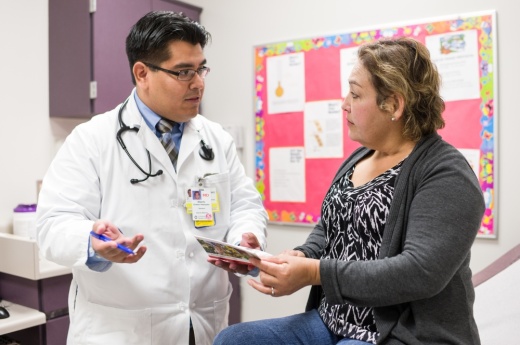Dr. Alberto Chavez-Velazquez is an endocrinologist with University Health. While his practice focuses on adults, he can speak to the overall prevalence of diabetes in the San Antonio community and the risks that impact all ages.
“I wanted to know what drives this pandemic—this silent pandemic which has been going on for years,” he said. “There is a lot of awareness and education that needs to be promoted to the general public.”
Type 2 diabetes occurs when the body does not process and use sugar as fuel, which leads to an excess of sugar in the bloodstream. Left unmanaged, high blood sugar levels can cause issues in the nervous, immune and circulatory systems.
Bexar County has one of the highest rates of diabetes in the United States. In the last two to three years, the incidence of diabetes or the prevalence of diabetes has been anywhere between 13% to 15% of the population. To put the number in perspective, the average rate in Texas is 12.6%, and the national average is 10.5%.
Prior to being officially diagnosed with the disease, patients are first considered to have prediabetes, but Chavez said, in many ways, it is as if this person already has diabetes. He said this is important because a lot of the complications experienced with diabetes can be seen in 10% to 15% of the population with prediabetes.
These symptoms can include:
- Retinopathy, which is the damage to the back of the eye because of high blood sugar levels;
- Neuropathy, which is damage to the nerves that can be manifested as tingling, numbness and/or pain in feet and hands; and
- Nephropathy which is the microscopic damage seen in urine as a result of protein leaks
“Having prediabetes is a huge red flag to take action,” Chavez said. “Some of the world's leading experts are coining a new term called ‘pre-pre-diabetes,’ which is when a person has not hit the number for prediabetes yet, but still has the physical findings. At that stage, we need to be focused on insulin resistance.”
There are multiple factors that can help determine whether a person is at risk for diabetes including genetic predisposition, a good diet and exercise, and carrying extra weight.
Another way to determine whether a person is experiencing symptoms of pre-diabetes is by measuring blood sugar. Chavez said the general definition of normal blood sugar is a blood glucose level of 99 or under in the fasting state.
If a person’s blood sugar is between 100-125 in a fasting state, then they are classified as having prediabetes. If the blood sugar is above 126 in a fasting state, this is classified as diabetes. In normal conditions, two hours after a meal, blood sugar should not be more than 140. If the blood sugar level is between 140-199, this is prediabetes; more than 199 is diabetes.
There is also a hemoglobin test, which can be ordered by any health care provider, that measures A1C levels. A1C is a blood test that measures a person’s average blood sugar levels over three months. Less than 5.6 is normal; 5.7-6.4 is pre-diabetic; 6.5 and up is diabetic.
Chavez said one of the main things people can do to lower their blood sugar level is to increase their physical activity. In addition, people can strive to lose 5-10% of their body weight. He recommended getting 150 minutes of physical activity every week, and just by doing this consistently, people can cut their risk of developing diabetes by 50%.
The good news? The development of type 2 diabetes does not happen overnight.
“One measurement doesn’t necessarily make the diagnosis,” Chavez said. “You won’t wake up overnight and have it. It can take months or years to develop. In many cases, the primary care provider is the first line of prevention and can start to identify physical findings of prediabetes.”
For higher-risk individuals, Chavez said exercise may be coupled with medication to help the pancreas produce insulin. Chavez said it is important to know there is no approved medication for prediabetes by the FDA, these are used off-label or in trials. Some of these medications are looking to be beneficial for the heart and kidneys as well as the liver and pancreas. They promote weight loss and can decrease the risk profile for people with prediabetes.
“I think the key here is identifying the mechanisms responsible for the progression from prediabetes to diabetes, so you can actually attack them purely,” Chavez said. “It's all based on the pathophysiology of the disease.”
Chavez said he has close friends who were affected in one way or another by diabetes.
“Having people close to your heart suffering from complications made me very aware of the consequences and impact,” he said. “When you dig a little deeper, obesity and prediabetes and diabetes account for a huge amount of the morbidity we see in the community.”
The above story was produced by Community Impact's Storytelling team with information solely provided by the local business as part of their "sponsored content" purchase through our advertising team. Our integrity promise to our readers is to clearly identify all CI Storytelling posts so they are separate from the content decided upon, researched and written by our journalism department.








